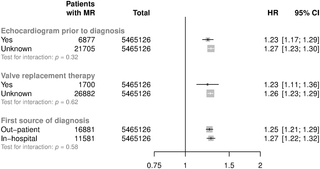Our official English website, www.x-mol.net, welcomes your feedback! (Note: you will need to create a separate account there.)
Elevated blood pressure and risk of mitral regurgitation: A longitudinal cohort study of 5.5 million United Kingdom adults.
PLOS Medicine ( IF 15.8 ) Pub Date : 2017-10-17 , DOI: 10.1371/journal.pmed.1002404 Kazem Rahimi 1, 2 , Hamid Mohseni 1 , Catherine M Otto 3 , Nathalie Conrad 1 , Jenny Tran 1 , Milad Nazarzadeh 4, 5 , Mark Woodward 1, 6, 7 , Terence Dwyer 1 , Stephen MacMahon 1, 6
PLOS Medicine ( IF 15.8 ) Pub Date : 2017-10-17 , DOI: 10.1371/journal.pmed.1002404 Kazem Rahimi 1, 2 , Hamid Mohseni 1 , Catherine M Otto 3 , Nathalie Conrad 1 , Jenny Tran 1 , Milad Nazarzadeh 4, 5 , Mark Woodward 1, 6, 7 , Terence Dwyer 1 , Stephen MacMahon 1, 6
Affiliation

|
BACKGROUND
Mitral regurgitation in people without prior cardiac disease is considered a degenerative disease with no established risk factors for its prevention. We aimed to test the hypothesis that elevated systolic blood pressure (SBP) across its usual spectrum is associated with higher risk of mitral regurgitation.
METHODS AND FINDINGS
We used linked electronic health records from the United Kingdom Clinical Practice Research Datalink (CPRD) from 1 January 1990 to 31 December 2015. CPRD covers approximately 7% of the current UK population and is broadly representative of the population by age, sex, and ethnicity. About 5.5 million UK patients with no known cardiovascular or valve disease at baseline were included in this cohort study. We investigated the relationship between blood pressure (BP) and risk of mitral regurgitation using Cox regression models. Our primary exposure variable was SBP and our primary outcome was incident reports of mitral regurgitation, which were identified from hospital discharge reports or primary care records. Of the 5,553,984 patients in the CPRD that met our inclusion criteria, during the 10-year follow-up period, 28,655 (0.52%) were diagnosed with mitral regurgitation and a further 1,262 (0.02%) were diagnosed with mitral stenosis. SBP was continuously related to the risk of mitral regurgitation with no evidence of a nadir down to 115 mmHg (p < 0.001). Each 20 mmHg increment in SBP was associated with a 26% higher risk of mitral regurgitation (hazard ratio [HR] 1.26; CI 1.23, 1.29). The observed association was partially mediated by diseases affecting the left ventricle during follow-up (myocardial infarction [MI], ischaemic heart disease [IHD], cardiomyopathy, and heart failure). However, the percentage of excess risk mediated (PERM) by these proximate causes of secondary mitral regurgitation was only 13% (CI 6.1%, 20%), and accounting for them had little effect on the long-term association between SBP and mitral regurgitation (mediator-adjusted HR 1.22; CI 1.20, 1.25; p < 0.001). Associations were similar for each 10 mmHg increment in diastolic blood pressure (DBP) (p < 0.001) or each 15 mmHg increment in pulse pressure (PP) (p < 0.001). By contrast, there was no association between SBP and risk of mitral stenosis (HR per 20 mmHg higher SBP 1.03; CI 0.93, 1.14; p = 0.58). These analyses are based on routinely collected data from health records which may be sensitive to measurement errors, and the observed associations may not be generalizable to less severe and subclinical cases of mitral regurgitation.
CONCLUSIONS
Long-term exposure to elevated BP across its whole spectrum is associated with an increased risk of primary and secondary mitral regurgitation. These findings suggest that BP control may be of importance in the prevention of mitral regurgitation.
中文翻译:

血压升高和二尖瓣反流的风险:一项针对550万英国成年人的纵向队列研究。
背景技术没有先天性心脏病的人的二尖瓣关闭不全被认为是变性疾病,其预防尚无确定的危险因素。我们旨在检验以下假设:收缩压(SBP)在其通常范围内升高与二尖瓣关闭不全的风险较高有关。方法和结果我们使用了1990年1月1日至2015年12月31日期间来自英国临床实践研究数据链(CPRD)的链接电子健康记录。CPRD覆盖了当前英国人口的大约7%,并且按年龄,性别大致代表了该人口和种族。这项队列研究包括了大约550万在基线时没有已知心血管或瓣膜疾病的英国患者。我们使用Cox回归模型调查了血压(BP)与二尖瓣反流风险之间的关系。我们的主要暴露变量为SBP,主要结果为二尖瓣关闭不全的事故报告,可从出院报告或初级保健记录中确定。在符合我们纳入标准的CPRD患者中,有5,553,984名患者,在10年的随访期间中,有28,655名(0.52%)被诊断为二尖瓣关闭不全,另外1,262名(0.02%)被诊断为二尖瓣狭窄。SBP与二尖瓣反流的风险持续相关,没有证据表明最低点降至115 mmHg(p <0.001)。SBP每增加20 mmHg,二尖瓣反流的风险增加26%(危险比[HR] 1.26; CI 1.23、1.29)。所观察到的关联部分由随访期间影响左心室的疾病(心肌梗塞[MI],缺血性心脏病[IHD],心肌病和心力衰竭)介导。然而,由这些继发性二尖瓣反流引起的超风险介导的比例仅为13%(CI 6.1%,20%),并且考虑到这些因素对SBP与二尖瓣反流之间的长期关联性影响很小(经中介人调整的HR 1.22; CI 1.20,1.25; p <0.001)。舒张压(DBP)每增加10 mmHg(p <0.001)或脉搏压(PP)每增加15 mmHg(p <0.001)的相关性相似。相比之下,SBP与二尖瓣狭窄风险之间没有关联(HR每增加20 mmHg,SBP 1.03; CI 0.93,1.14; p = 0.58)。这些分析基于从健康记录中定期收集的数据,这些数据可能对测量错误敏感,并且观察到的关联可能不适用于二尖瓣关闭不全的轻度和亚临床病例。结论长期暴露于整个血压范围内的BP与原发性和继发性二尖瓣关闭不全的风险增加有关。这些发现表明,在控制二尖瓣关闭不全中,血压控制可能很重要。
更新日期:2017-10-17
中文翻译:

血压升高和二尖瓣反流的风险:一项针对550万英国成年人的纵向队列研究。
背景技术没有先天性心脏病的人的二尖瓣关闭不全被认为是变性疾病,其预防尚无确定的危险因素。我们旨在检验以下假设:收缩压(SBP)在其通常范围内升高与二尖瓣关闭不全的风险较高有关。方法和结果我们使用了1990年1月1日至2015年12月31日期间来自英国临床实践研究数据链(CPRD)的链接电子健康记录。CPRD覆盖了当前英国人口的大约7%,并且按年龄,性别大致代表了该人口和种族。这项队列研究包括了大约550万在基线时没有已知心血管或瓣膜疾病的英国患者。我们使用Cox回归模型调查了血压(BP)与二尖瓣反流风险之间的关系。我们的主要暴露变量为SBP,主要结果为二尖瓣关闭不全的事故报告,可从出院报告或初级保健记录中确定。在符合我们纳入标准的CPRD患者中,有5,553,984名患者,在10年的随访期间中,有28,655名(0.52%)被诊断为二尖瓣关闭不全,另外1,262名(0.02%)被诊断为二尖瓣狭窄。SBP与二尖瓣反流的风险持续相关,没有证据表明最低点降至115 mmHg(p <0.001)。SBP每增加20 mmHg,二尖瓣反流的风险增加26%(危险比[HR] 1.26; CI 1.23、1.29)。所观察到的关联部分由随访期间影响左心室的疾病(心肌梗塞[MI],缺血性心脏病[IHD],心肌病和心力衰竭)介导。然而,由这些继发性二尖瓣反流引起的超风险介导的比例仅为13%(CI 6.1%,20%),并且考虑到这些因素对SBP与二尖瓣反流之间的长期关联性影响很小(经中介人调整的HR 1.22; CI 1.20,1.25; p <0.001)。舒张压(DBP)每增加10 mmHg(p <0.001)或脉搏压(PP)每增加15 mmHg(p <0.001)的相关性相似。相比之下,SBP与二尖瓣狭窄风险之间没有关联(HR每增加20 mmHg,SBP 1.03; CI 0.93,1.14; p = 0.58)。这些分析基于从健康记录中定期收集的数据,这些数据可能对测量错误敏感,并且观察到的关联可能不适用于二尖瓣关闭不全的轻度和亚临床病例。结论长期暴露于整个血压范围内的BP与原发性和继发性二尖瓣关闭不全的风险增加有关。这些发现表明,在控制二尖瓣关闭不全中,血压控制可能很重要。



























 京公网安备 11010802027423号
京公网安备 11010802027423号